October 9, 2023 dialog
This article has been reviewed according to Science X's editorial process and policies. Editors have highlighted the following attributes while ensuring the content's credibility:
fact-checked
trusted source
written by researcher(s)
proofread
Investigating a recently discovered Arabian Partridge population in Saudi Arabia's Harrat Uwayrid Biosphere Reserve
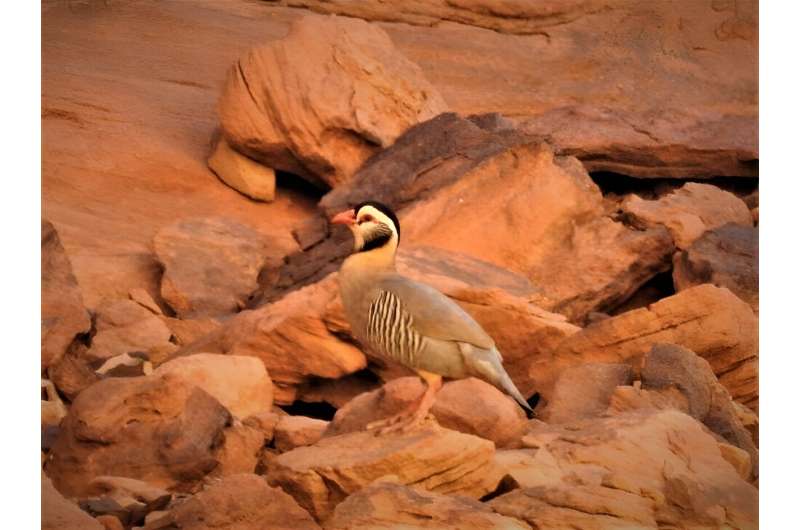
Forming a land bridge between Asia, Europe and Africa, the Arabian Desert hosts a distinctive wildlife community adapted to extreme conditions. Many of the rare, threatened and endemic species inhabiting this region have received little study or conservation attention due to the challenges of conducting fieldwork in this region's harsh climate and topography.
A poorly known Arabian desert endemic species, the Arabian Partridge (Alectoris melanocephala) has rarely been studied in the wild, and little is known about its conservation status. Fortunately, a population of this species was recently discovered ~100 km north of its previously known range, in the Harrat Uwayrid Biosphere Reserve, a recently declared UNESCO site in northwest Saudi Arabia.
As published information about the population trends and conservation status of the Arabian Partridge was not available, we set out to estimate, for the first time, the population size of this species in the Harrat Uwayrid Biosphere Reserve. Likewise, no specific potential threats to Arabian Partridges had been quantified, so we assessed factors that might influence its distribution, such as landscape features, vegetation cover, livestock grazing, hunting and the presence of feral animals, such as donkeys and dogs, in the reserve.
We predicted that partridge numbers would be higher in sites dominated by rocky outcrops and slopes, which provide cover and camouflage. We also predicted that disturbance due to livestock grazing and feral animals would adversely affect their numbers.
Arabian Partridges thrive in rocky outcrops and hilly desert terrain
Arabian Partridges are gregarious and typically found in coveys of 10 to 15 individuals, although group numbers as high as 27 have been reported. One of their many adaptations to desert life is that they do not require open water sources for drinking, as they are able to obtain their water requirements from food. They may be found at high altitudes of up to 2,800 m, where they feed on seeds, fresh leaves and invertebrates.
We conducted field surveys between May and September 2022 on 73 line transects distributed across the reserve. We used these counts to estimate the current Arabian Partridge population at ~118 individuals, with an estimated overall density of 25.6 (6.16 SE) birds/km2.
Partridge abundance positively associated with hillsides, which provide birds with cover from predators or hunters. Partridges observed were typically less than 10 meters from hillsides, indicating their importance. Birds typically fled for cover at the sight of people, indicating their fear and vigilance in response to potential threats.
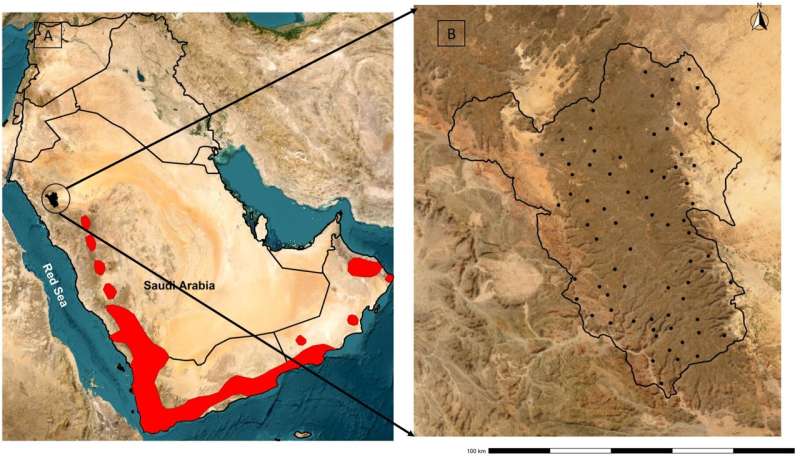
Hunting and donkey grazing have significant negative effects on partridge abundance
Hunting and livestock grazing are prohibited in the reserve, but we found evidence of hunting in almost 25% of sites surveyed and evidence of livestock grazing and the presence of feral donkeys in nearly 70% of surveyed sites. Our recent scientific publication in the journal Birds shows that feral donkeys, livestock grazing, and hunting negatively influence partridge abundance in the reserve. We found that moderate levels of disturbance from hunting, feral donkeys and livestock grazing resulted in a ~50% decline in partridge abundance compared to the sites with no disturbance.
Although we found evidence in hunting in only ~ 25% of the area we covered, it appeared to have an adverse impact on partridges. Hunting is considered one of the main threats to wildlife in Saudi Arabia.
Moreover, feral donkeys in the study area moved in herds averaging 10 animals. Although livestock grazing is not typically considered a major threat to birds, high grazing intensity may eliminate vegetation cover required by birds, and has been associated in other studies with decreased bird densities, nest abundance and recruitment. In this study, we found Arabian Partridge density was 23 times higher in sites without donkeys compared to sites with donkeys.
-
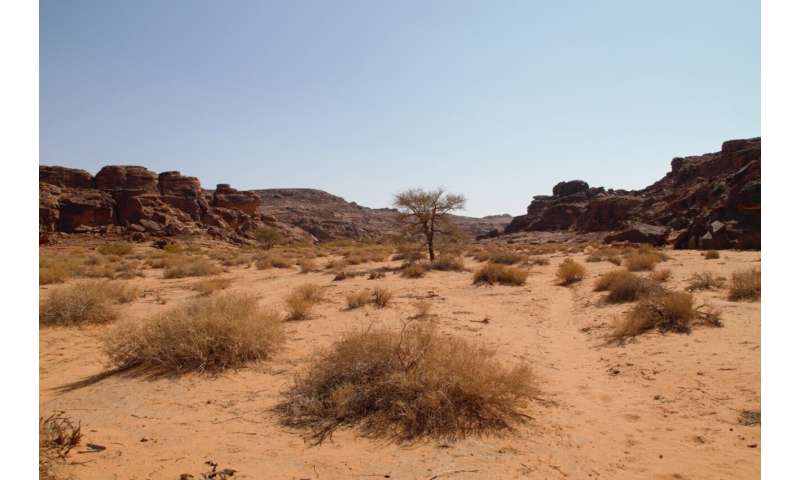
Landscape in Harrat Uwayrid Biosphere Reserve, Saudi Arabia. Credit: Alaaeldin Soultan -
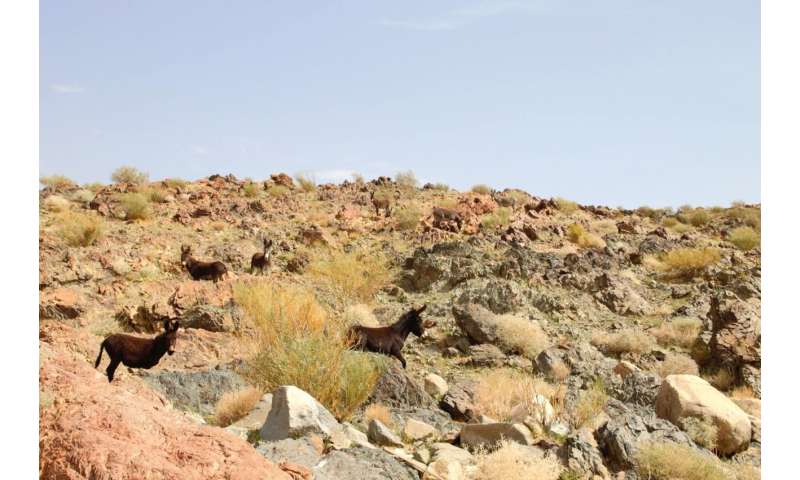
Feral donkeys grazing in Harrat Uwayrid Biosphere Reserve, Saudi Arabia Credit: Alaaeldin Soultan -
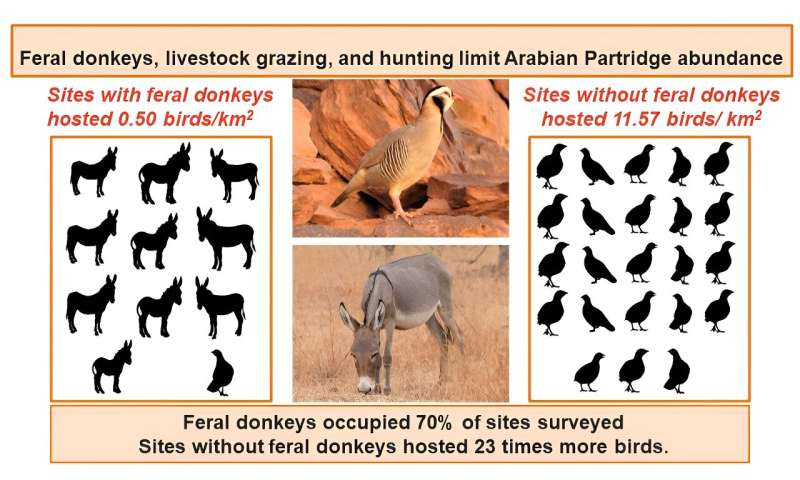
Arabian Partridge density was 23 times higher in sites without donkeys compared to sites with donkeys. Credit: Nico Arcilla
First but not last
Our study appears to be the first field-based attempt to estimate a population size and limiting factors for the Arabian Partridge, but we hope it is not the last. The recent discovery of this population appears to indicate a northward range shift of Arabian Partridges. This may be related to climate change, which is associated with northward range shifts in many other bird species.
To protect Arabian Partridge populations in the reserve, we recommend ranger patrols to prevent prohibited activities such as hunting and livestock grazing, a control program to remove feral animals and other non-native animals, and a monitoring program to track changes in the partridge population in response to threats and conservation actions. Such actions would benefit not only Arabian Partridges but other rare and endemic Arabian desert species.
This story is part of Science X Dialog, where researchers can report findings from their published research articles. Visit this page for information about ScienceX Dialog and how to participate.
More information: Alaaeldin Soultan et al, Arabian Partridge Abundance and Limiting Factors at the Northern Boundary of Its Range, Birds (2023). DOI: 10.3390/birds4020015
Alaaeldin Soultan, Moayyed Sher Shah, Ahmed Mohammed Almalki, and Stephen Browne are affiliated with The Royal Commission for AlUla, Al Safarat, Riyadh, Saudi Arabia. Moayyed Sher Shah and Ahmed Mohammed Almalki are also affiliated with King Salman Royal Nature Reserve, Olaya Towers, Riyadh, Saudi Arabia. Nico Arcilla is affiliated with the International Bird Conservation Partnership, Sweden, and the University of Nebraska-Lincoln, USA.



















